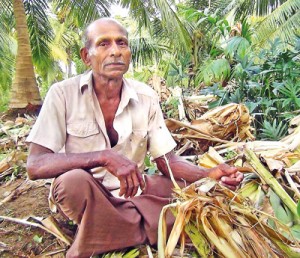News
Crop damage: Navy to import air rifles for farmers
The Agriculture Ministry is drawing up plans to distribute air rifles to farmers in view of the increasing number of reports of damage done by wild animals to agricultural crops.

A distraught farmer
The ministry, following cabinet approval to allow the distribution of air rifles to farmers, is seeking funds from the treasury to import these rifles.
According to the ministry’s Development Division Officer Champika Dharmasena, they are in contact with the Defence Ministry for the rifles to be imported by the Navy.
She says this will regularise the distribution of these rifles preventing bad practices and misuse of rifles for purposes other than what they were intended for.
At present although air rifles could be freely bought over the counter, the farmers are not buying them due to the high cost. An air rifle costs a farmer anywhere between Rs. 25,000 and Rs. 75,000 depending on its strength. However farmers who buy them have also found that they end up buying the wrong rifle that does not serve the purpose.
The determination of the air rifle’s velocity is important to a farmer when he shops for the weapon. Air rifles bought haphazardly and do not meet the needs of the farmer often end up useless in his home. The farmer needs to be educated on his requirements depending on which animal is threatening his cultivation. The Agriculture Ministry is preparing the specifications for farmers.
Also the Defence Ministry has been requested to lay down rules and regulations for the use of air rifles under the Arms and Ammunition Act. Guidelines will be drawn and a registration process introduced with issuance of a licence subject to annual renewal. The Defence Ministry is to maintain records of distribution and keep track of the weapons.
The action plan has been drafted jointly with eleven ministries, departments and agencies. They include the Ministry of Tourism Development, the Ministry of Land Reforms, the Ministry of Defence, Department of Wild Life Conservation, the Department of Agriculture, the police and the Attorney General’s Department.
Each ministry, department and agency will make proposals and suggestions to remedy the damage caused by wild animals to agricultural crops.
Other matters discussed include the installation of electric fences, increasing the quality of food and water available in the wild, utilisation of repellants, using of traditional methods, educating the farming community and identifying and strengthening ongoing projects.
According to the Ministry, there is no official survey being done on the crop damage caused by wild animals. The only research was done by the Hector Kobbekaduwa Research Training Institute (HARTI).
Senior Researcher Amal Dissanayake, whose research was confined to the agricultural areas of Moneragala and Ampara, found that although there is frequent reporting on wild elephants destroying cultivation, in reality less damage is caused to agriculture by elephants.
“It is the other animals that contribute to the amount of crops lost by farmers,” he said.
The researcher said these wild animals including the giant squirrel, wild boar, porcupine, rabbits, peacock and monkeys cause extensive damage to crops.
Monkeys have been found rampaging in coconut cultivation, plucking young fruits and destroying produce. A Moneragala farmer said that around 100,000 kurumba or young coconuts were lost every year. In addition porcupines attack potato cultivation digging into the roots.
Frustrated farmers despite their religious beliefs, resort to the killing of these animals by poisoning. They said they could not afford to spend big amounts on air rifles, and electrical fences have become less effective.
Moneragala coconut farmer A. Sirisena said most farmers lost their crops as they had no defence against the wild elephants. He said traditional methods such as catapulting, stoning and using fire crackers had proved futile.
He said shot guns were effective but they were issued only to farmers owning more than five acres of land. Also, clear deeds have to be produced as proof of eligibility to own a gun.
Peradeniya University’s Agriculture Faculty Professor Buddhi Marambe, who has done an extensive study on crop damage by wild animals to cultivation, said the main problem was the government’s indiscriminate development programmes which had not given consideration to wild life.
He said due consideration had to be given to the natural checks and balances of the ecosystem when settling people in new areas.
“We encroach on animal territory and then complain of attacks,” he said.
The best method was to control wildlife population.
“Selective slaughter is the best method of control. When governments do not take action people do it by themselves to protect their crops,” he said.

